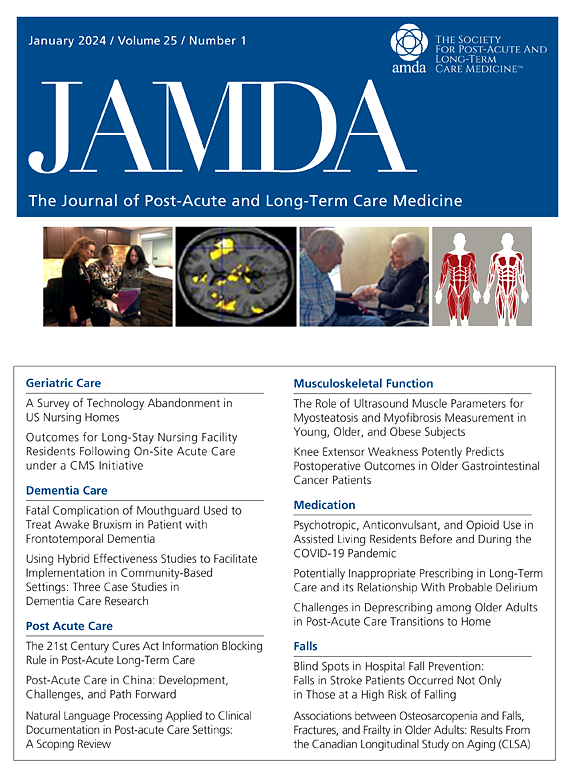Prospective Association Between Sarcopenia and Long-Term Risk of Hospitalization for Infection: A Cohort Study
IF 3.8
2区 医学
Q2 GERIATRICS & GERONTOLOGY
Journal of the American Medical Directors Association
Pub Date : 2025-06-13
DOI:10.1016/j.jamda.2025.105702
引用次数: 0
Abstract
Objectives
The relationship between sarcopenia and the long-term risk of hospitalization for infectious diseases is unclear. This study aimed to evaluate this relationship using a large prospective Caucasian cohort from the UK Biobank.
Design
This is a large prospective cohort study.
Setting and Participants
Using the UK Biobank data, participants were assessed for handgrip strength and appendicular lean mass at baseline and categorized into the non-sarcopenia, probable sarcopenia, and sarcopenia groups. A total of 243,097 participants (mean age, 55.64 years; 52.7% female) were enrolled in this study; 12,982 (5.3%) had probable sarcopenia and 312 (0.1%) had sarcopenia.
Methods
Cox regression analysis was used to evaluate associations between sarcopenia and subsequent hospitalizations for infections. The long-term risk of hospitalization for infections in different sarcopenia statuses was also examined.
Results
During the follow-up period (median, 13.54 years), 26,769 participants were hospitalized for infections, of whom 2357 (8.8%) had probable sarcopenia and 60 (0.2%) had sarcopenia. In the fully adjusted model, sarcopenia [hazard ratio (HR), 1.62; 95% confidence interval (CI), 1.25–2.08] and probable sarcopenia (HR, 1.40; 95% CI, 1.34–1.47) at baseline were prospectively associated with the risk of hospitalization for any infection. Sarcopenia was strongly associated with gastrointestinal infections (HR, 2.69; 95% CI, 1.27–5.68), whereas probable sarcopenia was associated with liver infections (HR, 1.76; 95% CI, 1.22–2.54). The average numbers of hospitalizations for infection were significantly higher in the probable sarcopenia and sarcopenia groups than in the non-sarcopenia group (P < .001 and P < .020, respectively). No significant difference was observed between the probable and confirmed sarcopenia groups (P = .684).
Conclusions and Implications
Sarcopenia may help identify people at risk of hospitalization for infections, supporting the strategies for enhancing infection prevention among individuals with sarcopenia.
肌肉减少症与感染住院长期风险的前瞻性关联:一项队列研究
目的:肌少症与感染性疾病长期住院风险之间的关系尚不清楚。本研究旨在利用来自英国生物银行的大型前瞻性高加索队列来评估这种关系。设计:这是一项大型前瞻性队列研究。环境和参与者:使用英国生物银行的数据,评估参与者在基线时的握力和阑尾瘦质量,并将其分为非肌肉减少症组、可能肌肉减少症组和肌肉减少症组。共有243,097名参与者(平均年龄55.64岁;(52.7%为女性)纳入本研究;12982例(5.3%)可能有肌肉减少症,312例(0.1%)有肌肉减少症。方法:采用Cox回归分析评估肌肉减少症与随后因感染住院之间的关系。对不同骨骼肌减少症患者感染住院治疗的长期风险也进行了研究。结果:在随访期间(中位13.54年),26,769名参与者因感染住院,其中2357名(8.8%)可能患有肌肉减少症,60名(0.2%)患有肌肉减少症。在完全调整模型中,肌肉减少症(风险比[HR], 1.62;95%可信区间[CI], 1.25-2.08)和可能的肌肉减少症(HR, 1.40;基线时的95% CI(1.34-1.47)与任何感染住院风险的前瞻性相关。肌肉减少症与胃肠道感染密切相关(HR, 2.69;95% CI, 1.27-5.68),而可能的肌肉减少症与肝脏感染相关(HR, 1.76;95% ci, 1.22-2.54)。可能肌少症组和肌少症组因感染住院的平均次数明显高于非肌少症组(P < 0.001和P < 0.020)。可能和确诊的肌少症组之间无显著差异(P = .684)。结论和意义:肌少症可能有助于识别有感染住院风险的人群,支持加强肌少症患者感染预防的策略。
本文章由计算机程序翻译,如有差异,请以英文原文为准。
求助全文
约1分钟内获得全文
求助全文
来源期刊
CiteScore
11.10
自引率
6.60%
发文量
472
审稿时长
44 days
期刊介绍:
JAMDA, the official journal of AMDA - The Society for Post-Acute and Long-Term Care Medicine, is a leading peer-reviewed publication that offers practical information and research geared towards healthcare professionals in the post-acute and long-term care fields. It is also a valuable resource for policy-makers, organizational leaders, educators, and advocates.
The journal provides essential information for various healthcare professionals such as medical directors, attending physicians, nurses, consultant pharmacists, geriatric psychiatrists, nurse practitioners, physician assistants, physical and occupational therapists, social workers, and others involved in providing, overseeing, and promoting quality

 求助内容:
求助内容: 应助结果提醒方式:
应助结果提醒方式:


